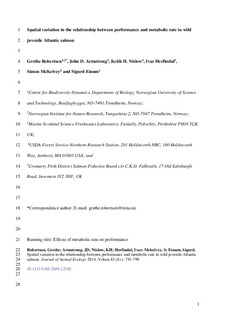Spatial variation in the relationship between performance and metabolic rate in wild juvenile Atlantic salmon
Journal article, Peer reviewed
Accepted version
Permanent lenke
http://hdl.handle.net/11250/2461206Utgivelsesdato
2014Metadata
Vis full innførselSamlinger
- Institutt for biologi [2615]
- Publikasjoner fra CRIStin - NTNU [38677]
Sammendrag
Maintenance of metabolic rate (MR, the energy cost of self-maintenance) is linked to behavioural traits and fitness and varies substantially within populations. Despite having received much attention, the causes and consequences of this variation remain obscure.
Theoretically, such within-population variation in fitness-related traits can be maintained by environmental heterogeneity in selection patterns, but for MR, this has rarely been tested in nature.
Here, we experimentally test whether the relationship between MR and performance can vary spatially by assessing survival, growth rate and movement of Atlantic salmon (Salmo salar L.) juveniles from 10 family groups differing in MR (measured as egg metabolism) that were stocked in parallel across 10 tributaries of a single watershed.
The relationship between MR and relative survival and growth rate varied significantly among tributaries. Specifically, the effect of MR ranged from negative to positive for relative survival, whereas it was negative for growth rate. The association between MR and movement was positive and did not vary significantly among tributaries.
These results are consistent with a fitness cost of traits associated with behavioural dominance that varies across relatively small spatial scales (within a single watershed). More generally, our results support the hypothesis that spatial heterogeneity in environmental conditions contributes to maintain within-population variation in fitness-related traits, such as MR.
